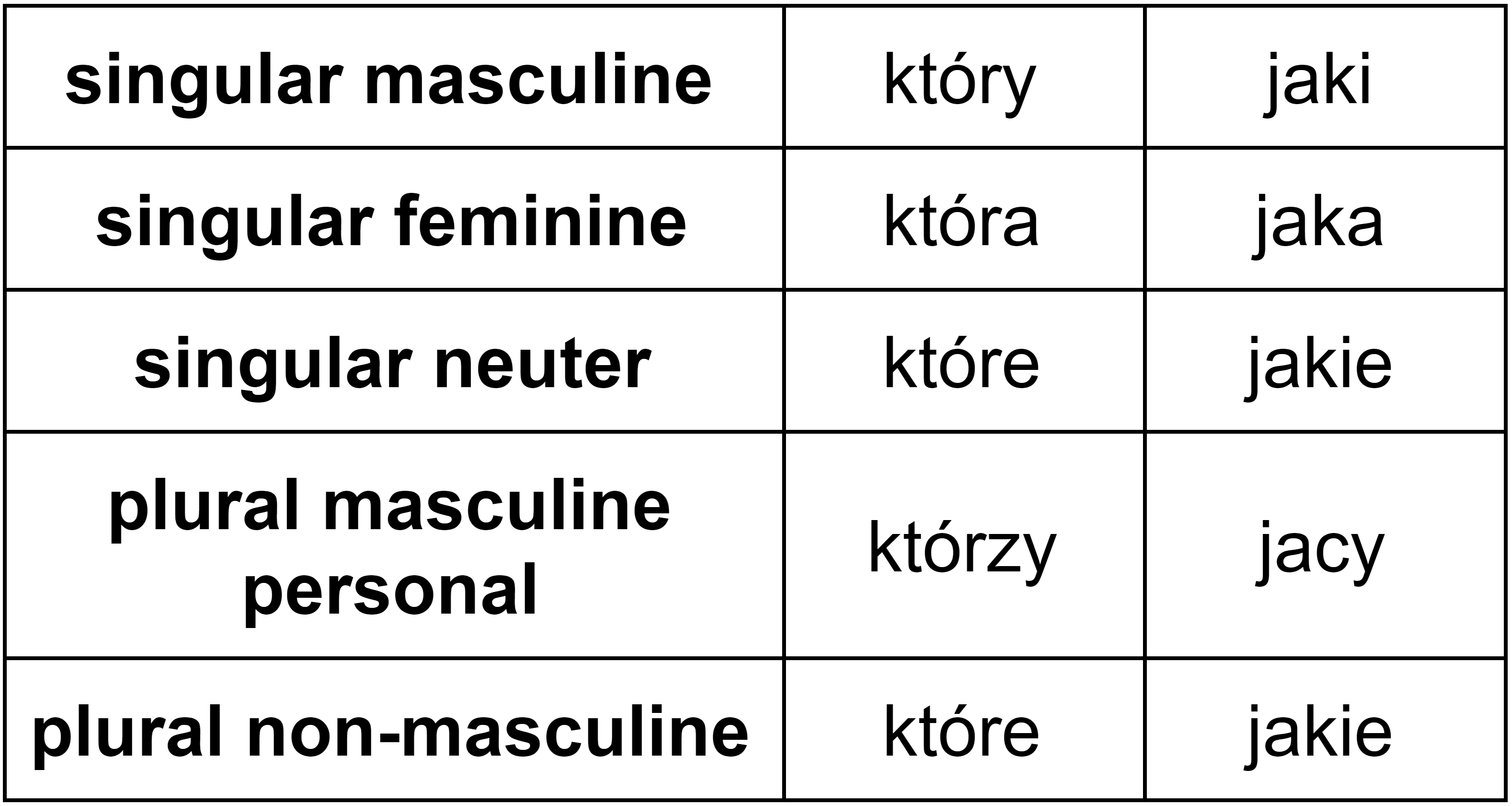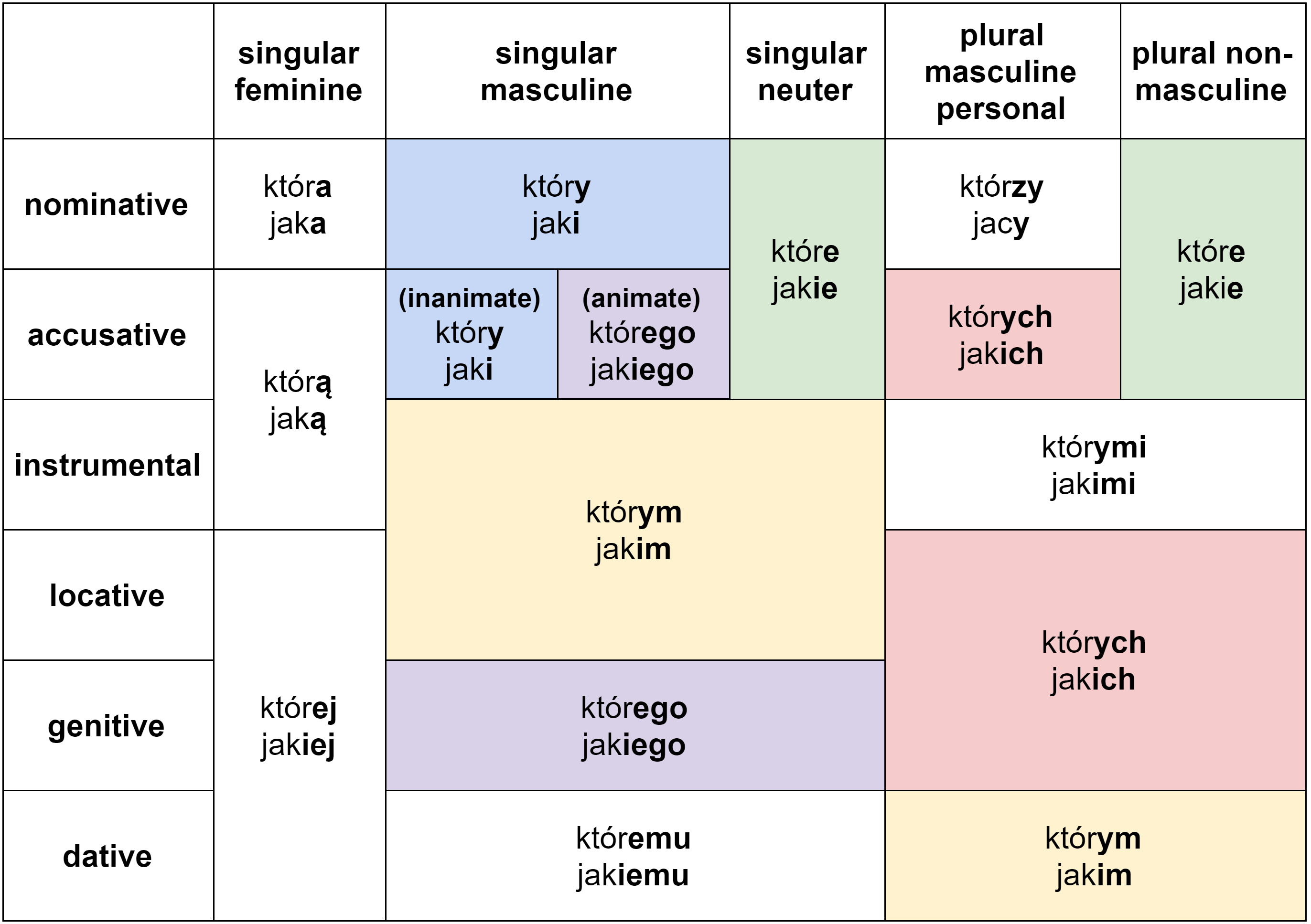Który and jaki as interrogative pronouns
The Polish pronouns który and jaki – mostly translated as which or what – have several uses. Probably the most straightforward one is asking questions.
Below are two example sentences with który and jaki as interrogative pronouns:
Który samochód podoba ci się bardziej, mój czy Toma? (“Which car do you like more, mine or Tom’s?”)
Jaki jest twój ulubiony deser? (“What is your favorite dessert?”)
Though their English translations are usually the same, the two pronouns can rarely be used interchangeably. Który is used when talking about entities that are being singled out from a specific number of options. On the other hand, jaki is used to refer to entities from a more indefinite set of options. It might seem a bit confusing when put this way, so let’s take a close look at some examples:
Który kraj Unii Europejskiej jest najbiedniejszy? (“What is the poorest country in the European Union?”)
The sentence refers to an entity belonging to a very specific group: the 28 member states of the European Union. Because of this, który is the preferred option.
Który z nich jest sprawcą? (“Which one of them is the perpetrator?”)
Here, the set of referents is a limited group of suspects – you can picture them standing in a police lineup. Once again, który is the way to go. The pronoun can be used for both human and non-human entities.
Jaki kolor ma jej sukienka? (“What color is her dress?”)
In this case, no specific set of colors to choose from comes to mind, and we cannot really rule out any answer – this is why jaki is the correct pronoun here. If the question included a specific set of colors to choose from, as in “Which color did you get – black or red?”, który would be the more appropriate option.
Jaki jest cel pańskiej wizyty? (“What is the purpose of your visit?”)
Once again, there isn’t a definite number of purposes to choose from. This makes jaki the preferred choice.
Który is also often used to ask about sequence, or anything else involving ordinal numbers:
Który był we wczorajszym wyścigu? (“What place did he finish yesterday’s race in?”)
Jaki can appear in questions asking about the class to which the given entity belongs, so it is sometimes translated as what kind of, what sort of or simply what:
Jaki ser lubisz najbardziej? (“What kind of cheese do you like the most?”)
Moreover, jaki is also used to ask about a person’s (or a thing’s) characteristics, which means it can be translated as what is … like:
Jaki jest jej mąż? (“What is her husband like?”)
Finally, jaki sometimes appears in exclamations that emphasize some specific adjective:
Jaki piękny widok! (“What a beautiful view!”)
Number and gender of który and jaki
Both który and jaki inflect just like adjectives do – they assume various endings depending on the number, gender, and case of the noun (or pronoun) they refer to.
Singular masculine forms: który, jaki
Thus, the forms który and jaki from the previous section are only used for singular masculine referents. Of course, these do not necessarily have to be actual males – we’re talking about grammatical gender, which all Polish nouns have.
Który rower podoba ci się bardziej? (“Which bicycle do you like more?”)
Jaki masz problem? (“What is your problem?”)
Singular feminine forms: która, jaka
When asking about singular feminine entities, the default forms are która and jaka:
Która jest córką Toma? (“Which one is Tom’s daughter?”)
Jaka jest dziś pogoda? (“What is the weather like today?”)
Singular neuter forms: które, jakie
Singular neuter nouns require the forms które and jakie:
Które mięso smakuje najlepiej? (“Which meat tastes the best?”)
Jakie jest twoje ulubione krajowe piwo? (“What is your favorite domestic beer?”)
Plural masculine personal forms: którzy, jacy
The plural masculine personal forms are którzy and jacy:
Którzy piłkarze grali dziś najlepiej? (“Which soccer players played the best today?”)
Jacy są jego rodzice? (“What are his parents like?”)
Finally, plural non-masculine nouns are accompanied by the forms które and jakie:
Które buty są twoje? (“Which shoes are yours?”)
Jakie książki czyta twój tata? (“What books does your dad read?”)

Grammatical case of który and jaki
Another grammatical feature that is reflected in the forms assumed by który and które is their grammatical case. A pronoun’s grammatical case is always the same as the case of its referent. This, in turn, depends on the referent’s function in the sentence.
Grammatical case exists in parallel to number and gender. This means that each of the five number/gender combinations described in the previous section has six independent forms, one for each of the cases.
Luckily, many of the forms are shared between cases and number/gender combinations, which brings their total number down to 11 for both który and jaki. The overlap is clearly visible in this color-coded table:

To help you digest all this information, let’s look at some examples and discuss the cases one-by-one.
Nominative
The nominative forms are used to ask about the subject of the sentence. In other words, you mostly use them to ask:
- which entity does something,
- which entity is something,
- what a given entity is like.
Która strona wygrała? (“Which side won?”)
Które ćwiczenie było najtrudniejsze? (“Which exercise was the hardest?”)
Jaki naprawdę jest Tom? (“What is Tom really like?”)
Jakie są wasze ulubione filmy? (“What are your favorite movies?”)
Accusative
The main purpose of the accusative forms is referring to the object of the sentence – that is, the entity to which something is being done.
Którego nauczyciela lubicie najbardziej? (“Which teacher do you like the most?”)
Których kandydatów powinniśmy zatrudnić? (“Which applicants should we hire?”)
Jaką gazetę czyta twój mąż? (“What newspaper does your husband read?”)
Jakie dostałeś prezenty? (“What gifts did you get?”)
Instrumental
Uses of the instrumental forms usually involve one of the following:
- the verbs być (“to be”), zostać (“to become”),
- certain prepositions, such as z (“with”), przed (“before” / “in front of”), and za (“behind”),
- the means (= the instrument) used to do something.
Którą łyżką jadłeś zupę? (“Which spoon did you eat your soup with?”)
Z którymi studentami rozmawiałaś? (“Which students did you talk to?”)
Jakim samochodem jechał Tom? (“What kind of car was Tom driving?”)
Jakimi jesteście rodzicami? (“What sort of parents are you?”)
Locative
The locative forms are only used together with certain prepositions, among others o (“about”), w (“in”), and na (“on”).
W którym domu mieszkała twoja babcia? (“Which house did your grandma live in?”)
O której dziewczynie rozmawiacie? (“Which girl are you talking about?”)
Na jakim kanale mogę obejrzeć ten mecz? (“On what channel can I watch this match?”)
O jakich ludziach jest ten film? (“What kind of people is this movie about?”)
Genitive
The genitive forms are usually used to refer to:
- the direct object in a negative sentence,
- the direct object of verbs such as szukać (“to look for”), potrzebować (“to need”), or używać (“to use”),
- objects following the prepositions dla (“for”), od (“from”), and do (“to”).
Którego aktora nie lubisz najbardziej? (“Which actor do you dislike the most?”)
Dla której firmy pracujecie? (“Which company do you work for?”)
Jakich przedmiotów uczysz się w szkole? (“What subjects do you study at school?”)
Jakiego rodzaju muzyki słuchasz? (“What kind of music do you listen to?”)
Dative
Finally, the purpose of the dative forms is indicating:
- the indirect object of the sentence (someone or something to whom or for whom an action is done),
- the object of verbs such as dawać (“to give”), wierzyć (“to believe”), dziękować (“to thank”), or pomagać (“to help”).
Której kobiecie wierzysz? (“Which woman do you believe?”)
Któremu pracownikowi powinniśmy dać podwyżkę? (“Which employee should we give a rise?”)
Jakim ludziom pomaga ta organizacja charytatywna? (“What kind of people does this charity help?”)
Jakiej drużynie kibicujesz? (“What sports team do you support?”)
Który and jaki as relative pronouns
Another common purpose of który and jaki is introducing relative clauses. These are grammatical units supplying additional information about a noun (or a pronoun):
Czy to ten samochód, który wczoraj widziałaś? (“Is this the car that you saw yesterday?”)
Tom to najlepszy gość, jaki tu kiedykolwiek pracował. (“Tom is the best guy that has ever worked here.”)
When used as relative pronouns, który and jaki can usually be translated as that, which or who.
Yes, even who. As briefly mentioned above, both Polish relative pronouns can be used with personal and impersonal nouns:
Mam wujka, który mieszka w Warszawie. (“I have an uncle who lives in Warsaw.”)
Note that it’s impossible to omit który the way you could sometimes omit which, that or who. In other words, saying “samochód wczoraj widziałeś” is a serious error in Polish, while “the car you saw yesterday” is perfectly fine in English.
And finally, it’s important to remember that when który and jaki are used as relative pronouns, they have to be preceded by a comma – yet another difference between Polish and English.
Just as in questions, który is used when talking about entities “selected” from a specific number of options, and jaki is used for entities belonging to a more indefinite set of options.
Naturally, który and jaki used as relative pronouns still assume different endings depending on the number, gender, and case of the noun they refer to. The declension table from the previous section will be just as useful as before.
Relative pronouns can appear after prepositions. These cannot, however, be split from the pronoun like in English:
Firma, dla której pracuję, sprzedaje papier. (“The company that I’m working for sells paper.”)
It is important to remember that the grammatical case of the relative pronoun is governed by the dependent clause, and not the one immediately preceding the pronoun. Thus, in the example above, który takes the genitive form required by the preposition dla, rather than the nominative form which would match the case of the noun firma at the beginning of the sentence.
To finish up, here are some more examples with various forms of the Polish relative pronouns który and jaki:
Zgubiłem zegarek, który dał mi ojciec. (“I lost the watch that my father gave me.”)
Książka, którą kupiłem w zeszłym tygodniu, była naprawdę ciekawa. (“The book I bought last week was really interesting.”)
Zaznacz słowa, których nie rozumiesz. (“Mark the words that you don’t understand.”)
Tom jest najwyższym człowiekiem, jakiego znam. (“Tom is the tallest man I know.”)
To jest najsmaczniejsza pizza, jaką kiedykolwiek jadłem. (“This is the most delicious pizza I’ve ever eaten.”)
To najlepsze buty, jakie mam. (“These are the best shoes I have.”)
The Polish Pronoun Grammar Challenge
If you want to learn more about Polish pronouns, you don’t need any more explanations. You need actual practice and feedback.
Check out the Polish Pronoun Grammar Challenge and start testing yourself by filling in the gaps in hundreds of Polish sentences.


Pingback: How to Start Learning Polish and Not Give Up - ForgottenDocs
Thank you so much for publishing this post. This is by far the best guide I have found for using “Jaki” and “który”.
Could you shed any light on the use of “co”? When should I use “co” rather than “Jaki”?
Thank you 🙂
Hi Ed! Glad you found the post helpful.
We have covered this in a post focusing on the pronouns “kto” and “co” here: https://www.clozemaster.com/blog/polish-interrogative-pronouns/
Take a look at the section “Kto and co as relative pronouns”—it outlines some cases that are analogous to these covered in this very post.
Thanks for reading!